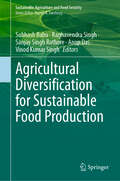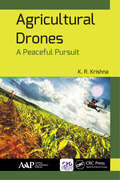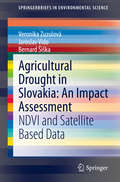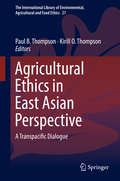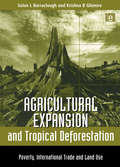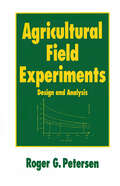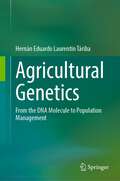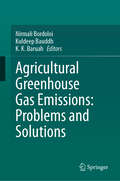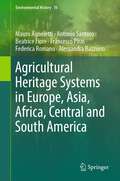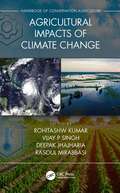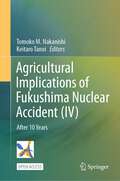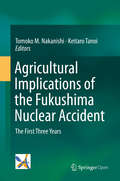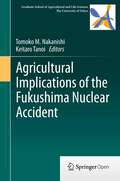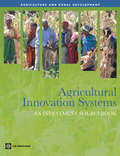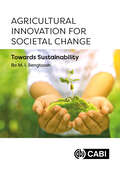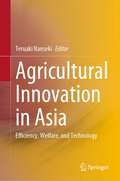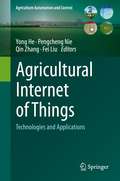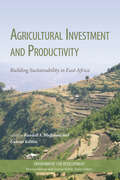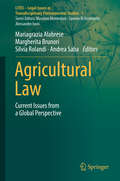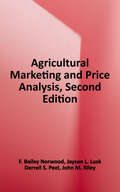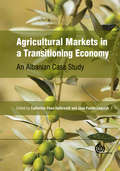- Table View
- List View
Agricultural Dimensions of Global Climate Change
by Harry Kaiser Thomas DrennenThis important book, written by recognized leaders in their fields, discusses agricultural dimensions of global climate change. Research and policy issues are covered and a multidisciplinary view of global climate change and agriculture is presented. Major sections cover the contribution of agriculture to greenhouse gas (GHG) emissions (including an investigation as to whether monitoring and verification of such emissions would work) and the impact of global climate change on agriculture. The book examines such important issues as global food availability, distributional effects between developing and developed countries, agricultural adaptation possibilities, and whether CO2 enrichment will benefit agriculture. A unique feature of this publication is that it addresses communication difficulties between researchers and policy makers and suggests solutions.
Agricultural Diversification for Sustainable Food Production (Sustainability Sciences in Asia and Africa)
by Anup Das Vinod Kumar Singh Subhash Babu Raghavendra Singh Sanjay Singh RathoreThis book discusses agricultural diversification, nutritional security and environmental sustainability. It helps to address the multipronged challenges of nutritional security while preserving the dwindling natural resources in the current fluctuating climate conditions. Energy-intensive, conventional agricultural production systems accelerate environmental footprints, resource mining, biodiversity losses, and human health problems and reduce soil functionality. Diversified farming can potentially enhance yield, food security, and climate change buffering as it helps to achieve advanced food security by efficient resource use and profit maximization. This book covers the challenges faced during the adoption of diversified farming and opportunities to enhanced food production and minimize the environmental footprints. This book is useful for academicians, researchers, ecologists, environmentalists, students, capacity builders, and policymakers to have in-depth knowledge of this complex and diverse field. This book also helps in devising a road map for policy planning and advancement of existing knowledge for various stakeholders working in this field.
Agricultural Drones: A Peaceful Pursuit
by K. R. KrishnaAgricultural drones are expected to revolutionize the way we conduct agronomic procedures and maintain natural vegetation on earth. This book explores the increasing importance of the role of aerial robots in managing agricultural farms and natural resources. Agricultural Drones: A Peaceful Pursuit provides a wealth of information on drone usage in agriculture. The book discusses the advanced sensors and imaging capabilities of drones that give farmers new ways to increase yields and reduce crop damage. An introductory chapter provides historical data, with details about various models of drones as well as the most recent and popular agricultural drones in usage. The book goes onto look at such topics as the use of drones for soil fertility, production agronomy, irrigation, weed control, pest and disease control, grain yield forecasting, and economic advantages from drone use. This timely and useful volume will be a valuable resource for faculty, agricultural extension officers, and farmers and farm consultancy agencies. This book would also serve as an excellent textbook for students in agriculture, engineering, geography, etc. Key features: • outlines the advantages of using drones in agriculture, such as for the management of soil fertility, the study of natural resources and vegetation, the maintenance of adequate irrigation, and the control of weeds and pests • covers the economic advantages of using drones in agriculture • examines the regulatory aspects of agricultural drones • provides actual examples of drone usage in agriculture
Agricultural Drought in Slovakia: NDVI and Satellite Based Data (SpringerBriefs in Environmental Science)
by Veronika Zuzulová Jaroslav Vido Bernard ŠiškaThis book gives an insight into the evaluation of drought in Slovakia and provides an assessment of Normalized Difference Vegetation Index (NDVI) as a method suitable for an evaluation of drought in agricultural land. Dry seasons in the time series from 1960 to 2014 were determined according to the monthly Palmer Drought Severity Index (PDSI). The field research was carried out on 12 sites including western Slovakia, Prešov, Trnava and Nitra regions. Data collected from satellite imagery, climate data analyses and drought indices was analysed to determine the value of NDVI as an evaluation tool.
Agricultural Ecology
by Joy TivyThis book analyses the nature of the relationships between crops, livestock and the bio-physical environment, and the extent to which man has managed and modified the products and environment to suit his/her own particular needs.
Agricultural Engineering Volume 2: Proceedings of the Eleventh International Congress on Agricultural Engineering, Dublin, 4-8 September 1989
by VINCENT A.DODD; PATRICK M.GRACEThis set of proceedings volumes provides a broad coverage of basic and applied research projects dealing with the application of engineering principles to both food production and processing. The set consists of the following four volumes: Land and water use, Agricultural buildings, Agricultural mechanisation and Power, processing and systems. Includes about 450 papers from over 50 countries worldwide, drawn from the Eleventh International Congress on Agricultural Engineering, Dublin, 4-8 September 1989.
Agricultural Ethics in East Asian Perspective: A Transpacific Dialogue (The International Library of Environmental, Agricultural and Food Ethics #27)
by Paul B. Thompson Kirill O. ThompsonThis book brings together agricultural ethics scholars from the US, Japan and Taiwan to discuss crucial issues in agricultural ethics and sustainability ethics in comparative context. Agricultural ethics and sustainability ethics are wide-ranging and closely linked to environmental ethics, bioethics, virtue ethics, animal welfare, soil conservation, not to mention rural traditions and lifestyles. Six of the chapters cover historical traditions and values in Europe, the US and East Asia. Four of the chapters cover the role of virtue ethics in the analysis of agrarian and environmental ethics, agricultural biotechnology, food ethics, and alternative agriculture, respectively. Finally, two of the chapters cover field efforts of agricultural ethics involving preserving agricultural heritage and building consensus for sustainable farming, respectively. Although the papers are divided into three groups, their contents are interconnected and mutually informative.
Agricultural Expansion and Tropical Deforestation: International Trade, Poverty and Land Use
by Solon L. BarracloughThere is no clear-cut causal relationship between international trade, agricultural expansion and tropical deforestation. Academics, policy-makers and the public are all tempted by simplistic solutions to complex problems. In order to establish the true causal factors involved in this critical area of environmental decline, the authors of this study present case studies ranging over three continents. Utilizing statistics, it is shown that the focus of analysis of deforestation must be applied as much to the misguided policies of national and regional authorities as to the forces of trade and globalization. Further, it demonstrates that we must adopt a critical perspective on the historical context of human use of forest areas, looking at issues such as systems of land tenure. The primary aim of the book is to highlight the need to seek solutions in far-reaching institutional and policy reforms adapted to specific socio-economic and ecological contexts, if the problem of tropical deforestation is to be tackled effectively.
Agricultural Field Experiments: Design and Analysis (Books in Soils, Plants, and the Environment #Vol. 31)
by Roger G. PetersenThis text provides statistical and biometrical procedures for designing, conducting, analyzing and interpreting field experiments. It addresses the most important research topics in agriculture, including agronomy, breeding and pasture trials; farming systems research; and intercropping research.
Agricultural Genetics: From the DNA Molecule to Population Management
by Hernán Eduardo Laurentin TáribaReaders will find in this book a comprehensive text on the intersection of genetic and agriculture, addressing the different levels at which DNA is studied for agricultural purposes. The different subdivisions of genetics (molecular, Mendelian, quantitative and populations) are all discussed in the light of agriculture research and practice. Agricultural Genetics aims to be a support for advanced and undergraduate students taking courses on biology, genetics and breeding applied to agriculture, both for plant sciences and animal sciences.
Agricultural Greenhouse Gas Emissions: Problems and Solutions
by Kuldeep Bauddh Nirmali Bordoloi K. K. BaruahThis book collects information on greenhouse gas (GHG) emissions, especially from the agro-ecosystems. It highlights the GHG emission mitigation measures using environmentally viable and cost-effective technologies. The title deals with the evaluation of the emission of GHGs from different agriculture sources, estimates the emission trends, analyzes the affecting drivers and assesses the feasible and suitable mitigation options for local farmers. Agricultural activities including land clearing, crop cultivation, fertilizer application, irrigation pattern, animal husbandry and fisheries have a significant impact on GHG production and emissions. The application of excess amount of inorganic fertilizer to increase the crop production may also boost the emissions of GHGs from agricultural fields. Therefore, it is urgent to concurrently quantify the fluxes of GHGs, improve understanding of gaseous emissions from different agricultural sources and to develop mitigation strategies to reduce the future climate chaos. This book is of interest to the farmers, horticulturists, scientists, ecologists, and a valuable source of reference to the relevant researchers and students in the region. Also, the book serves as additional reading material for undergraduate and graduate students of environmental science, agriculture, animal husbandry, ecology and soil science.
Agricultural Heritage Systems in Europe, Asia, Africa, Central and South America (Environmental History #16)
by Mauro Agnoletti Antonio Santoro Beatrice Fiore Francesco Piras Federica Romano Alessandra BazzurroAgriculture is often considered as one of the main threats to ecosystems. Unsustainable farming practices often result in habitat loss, inefficient use of water, soil degradation, pollution, genetic erosion, among other negative impacts on human life, including hunger, low food quality, reduced access to food resources, as well as the abandonment of rural areas. Nevertheless, when agriculture is practiced in a sustainable way, it can contribute to the preservation of many habitats, to the protection of watersheds, to the preservation and improvement of soil health.The use of sustainable and ecological practices is the key feature distinguishing traditional agriculture from intensive one. It may not provide very high yields, but ensures sustainable harvests over time, thanks to time-tested technologies and traditional know-hows and also represent examples of adaptation to harsh environmental conditions. Based on this approach, in 2002, FAO launched the concept of Globally Important Agricultural Heritage Systems (GIAHS) Programme, to identify and safeguard agricultural systems that are ensuring food and livelihood security, while maintaining magnificent landscapes, agricultural biodiversity, traditional knowledge, cultural and social values.This book presents 18 examples of these traditional agriculture systems around the world, with a special focus on Europe, Asia, Africa, Central and South America, as a result of the “GIAHS Building Capacity” project co-funded by the Italian Agency for Development Cooperation (AICS) and carried out by the Department of Agriculture, Food, Environment and Forestry (DAGRI) of the University of Florence (Italy).
Agricultural Impacts of Climate Change [Volume 1]
by Vijay P. Singh Rohitashw Kumar Deepak Jhajharia Rasoul MirabbasiConservation agriculture is a sustainable production model that not only optimizes crop yields, but also reaps economic and environmental benefits as well. The adoption of successful conservation agriculture methods has resulted in energy savings, higher organic matter content and biotic activity in soil, increased crop-water availability and thus resilience to drought, improved recharge of aquifers, less erosion, and reduced impacts from the weather associated with climate change in general. Agricultural Impacts of Climate Change examines several important aspects of crop production, such as climate change, soil management, farm machinery, and different methods for sustainable conservation agriculture. It presents spatial distribution of a daily, monthly and annual precipitation concentration indices, Diffuse Reflectance Fourier Transform Infrared Spectroscopy for analyzing the organic matter in soil, and adaptation strategies for climate-related plant disease scenarios. It also discusses solar energy-based greenhouse modeling, precision farming using remote sensing and GIS, and various types of machinery used for conservation agriculture. Features: Examines the effects of climate change on agriculture and the related strategies for mitigation through practical, real-world examples Explores innovative on-farm technology options to increase system efficiency resulting in improved water usage Presents examples of precision farming using climate-resilient technologies
Agricultural Implications of Fukushima Nuclear Accident (IV): After 10 Years
by Keitaro Tanoi Tomoko M. NakanishiThis open access book presents the findings from on-site research into radioactive cesium contamination in various agricultural systems affected by the Fukushima Daiichi Nuclear Power Plant accident in March 2011. This fourth volume in the series reports on studies undertaken at contaminated sites such as farmland and forests, focusing on soil, water, mountain, agricultural products, and animals. It also provides additional data collected in the subsequent years to show how the radioactivity levels in agricultural products and their growing environments have changed with time and the route by which radioactive materials entered agricultural products as well as their movement between different components (e.g., soil, water, and trees) within an environmental system (e.g., forests). The book covers various topics, including radioactivity testing of food products; decontamination trials for rice and livestock production; the state of contamination in, trees, mushrooms, and timber; the dynamics of radioactivity distribution in paddy fields and upland forests; damage incurred by the forestry and fishery industries; and the change in consumers’ attitudes. In the series of this book, a real-time radioisotope imaging system has been introduced, a pioneering technique to visualize the movement of cesium in soil and in plants. This is the only book to provide systematic data on the actual change of radioactivity, which is of great value to all researchers who wish to understand the effect of radioactive fallout on agriculture. In addition, it helps the general public better understand radio-contamination issues in the environment. The project is ongoing; the research groups from the Graduate School of Agricultural and Life Sciences of The University of Tokyo continue their work in the field further to evaluate the long-term effects of the Fukushima accident.
Agricultural Implications of the Fukushima Nuclear Accident: The First Three Years
by Keitaro Tanoi Tomoko M. NakanishiFollowing the Fukushima nuclear accident, a large volume of monitoring data has been collected about the soil, air, dust, and seawater, along with data about an immense number of foods supplied to the market. Little is known, however, about the effect of radioactive fallout on agriculture, information about which is vital. Although more than 80% of the damaged area is related to agriculture, in situ information specifically for agriculture is scarce. This book provides data about the actual movement and accumulation of radioactivity in the ecological system--for example, whether debris deposited on mountains can be a cause of secondary contamination, under what conditions plants accumulate radioactive cesium in their edible parts, and how radioactivity is transferred from hay to milk. Because agriculture is so closely related to nature, many specialists with different areas of expertise must be involved in answering these questions. In the case of rice, researchers in rice cultivation as well as in soil, hydrology, and radioactivity measurement are working together to reveal the paths or accumulation of radioactivity in the field. For this purpose, the Graduate School of Agricultural and Life Sciences of The University of Tokyo has diverse facilities available throughout Japan, including farmlands, forests, and meadowlands. Many academic staff members have formed groups to conduct on-site research, with more than 40 volunteers participating. This book presents the data collected from the only project being systematically carried out across Japan after the Fukushima accident.
Agricultural Implications of the Fukushima Nuclear Accident: The First Three Years
by Keitaro Tanoi Tomoko M. NakanishiFollowing the Fukushima nuclear accident, a large volume of monitoring data has been collected about the soil, air, dust, and seawater, along with data about an immense number of foods supplied to the market. Little is known, however, about the effect of radioactive fallout on agriculture, information about which is vital. Although more than 80% of the damaged area is related to agriculture, in situ information specifically for agriculture is scarce. This book provides data about the actual movement and accumulation of radioactivity in the ecological system—for example, whether debris deposited on mountains can be a cause of secondary contamination, under what conditions plants accumulate radioactive cesium in their edible parts, and how radioactivity is transferred from hay to milk. Because agriculture is so closely related to nature, many specialists with different areas of expertise must be involved in answering these questions. In the case of rice, researchers in rice cultivation as well as in soil, hydrology, and radioactivity measurement are working together to reveal the paths or accumulation of radioactivity in the field. For this purpose, the Graduate School of Agricultural and Life Sciences of The University of Tokyo has diverse facilities available throughout Japan, including farmlands, forests, and meadowlands. Many academic staff members have formed groups to conduct on-site research, with more than 40 volunteers participating. This book presents the data collected from the only project being systematically carried out across Japan after the Fukushima accident.
Agricultural Innovation Systems
by the editors at The World BankResearch, education, and extension investments, while usually necessary, are often insufficient alone to bring knowledge, technologies, and services that enable farmers and entrepreneurs to innovate. Efforts to strengthen research systems and increase the availability of knowledge have not increased innovation or the use of knowledge in agriculture at the pace or the scale required by the intensifying and proliferating challenges confronting agriculture. Agricultural Innovation Systems: An Investment Sourcebook contributes to the identification, design, and implementation of the investments, approaches, and complementary interventions most likely to strengthen agricultural innovation systems (AIS) and to promote innovation and equitable growth. The Sourcebook provides a menu of tools and operational guidance, as well as good practice lessons, to illustrate approaches to designing, investing in, and improving these systems. Managing the ability of agriculture to meet rising global demand and to respond to the changes and opportunities will require good policy, sustained investments, and innovation—not business as usual. Experience indicates that aside from a strong capacity in R&D, the ability to innovate is often related to collective action and coordination, exchange of knowledge among diverse actors, incentives and resources available to form partnerships and develop business, and an enabling environment. While consensus is developing about what is meant by 'innovation' and 'innovation system,' no detailed blueprint exists for making agricultural innovation happen at a given time, in a given place, for a given result. That said, the AIS approach, which looks at these multiple conditions and relationships that promote innovation in agriculture in specific contexts, has moved from a concept to a subdiscipline with principles of analysis and action. Drawing on approaches that have been tested at different scales in different settings, this Sourcebook emphasizes the lessons learned, benefits and impacts, implementation issues, and prospects for replicating or expanding successful practices. The Sourcebook reflects the experiences and evolving understanding of numerous individuals and organizations concerned with agricultural innovation, including the World Bank. It targets the key operational staff who design and implement lending projects in international and regional development agencies and national governments, as well as the practitioners who design thematic programs and technical assistance packages. The Sourcebook can also be an important resource for the research community and nongovernmental organizations.
Agricultural Innovation for Societal Change: Towards Sustainability
by Dr Bo Malte BengtssonOver the centuries, agriculture has developed through technological steps illustrated by various agricultural revolutions. This book describes and analyses significant agricultural changes since the mid-1960s in the context of development, innovation and adoption by revisiting resource-poor farmers in Ethiopia, Sweden and Trinidad and Tobago, and considering overall development changes up to the early 2020s. It is a platform for discussing current issues for future global food security in the context of globalization and free global trade which have influenced economic growth in many countries but also created environmental concerns and a rapid increase in the number of transnational corporations (TNCs). Sustainable food production is now a global priority and therefore ecological footprints must be reduced - this book provides examples of possible technical changes required to achieve this. Reducing greenhouse gas emissions alone is insufficient: political attention must be paid to declining biodiversity, the increasing global exploration of natural resources, demography, increased consumption, waste mountains, expanding migration and antibiotic resistance. Agribusiness TNCs will challenge national governments and international donors in both research and development, increasing competition for leadership. A gradual societal change, incorporating an understanding of biological fundamentals, is necessary for achieving sustainability and for leading us towards the next agricultural revolution.
Agricultural Innovation in Asia: Efficiency, Welfare, and Technology
by Teruaki NansekiThis book covers the major findings of almost all types of innovation in agriculture that includes product and process innovation, marketing and organizational innovation, and extended to institutional changes and social welfare in agricultural innovation in Asia. Specially, this book provides the measuring of these types of agricultural innovation on production, economics, and social welfare. Furthermore, this book provides the overview of smart farming in two advanced countries in Asia in this field, which are China and Japan along with its innovation. This book also aims to give an overview on the development of agricultural innovation in the era of digital agriculture over the world.
Agricultural Internet of Things: Technologies and Applications (Agriculture Automation and Control)
by Fei Liu Qin Zhang Yong He Pengcheng NieInternet of things (IoT) is a new type of network that combines communication technology, expanded applications, and physical devices. Among them, agriculture is one of the most important areas in the application of the IoT technology, which has its unique requirements and integration features. Compared to the information technology in traditional agriculture, the agricultural IoT mainly refers to industrialized production and sustainable development under relatively controllable conditions. Agricultural IoT applies sensors, RFID, visual capture terminals and other types of sensing devices to detect and collect site information, and with broad applications in field planting, facility horticulture, livestock and poultry breeding, aquaculture and agricultural product logistics. It utilizes multiple information transmission channels such as wireless sensor networks, telecommunications networks and the internet to achieve reliable transmission of agricultural information at multiple scales and intelligently processes the acquired, massive information. The goals are to achieve (i) optimal control of agricultural production process, (ii) intelligent electronic trading of agricultural products circulation, and (iii) management of systematic logistics, quality and safety traceability. This book focuses on three levels of agricultural IoT network: information perception technology, information transmission technology and application technology.
Agricultural Investment and Productivity: Building Sustainability in East Africa
by Randall Bluffstone Gunnar K�hlinAgricultural Investment and Productivity provides a deep and systematic look at the opportunities for and constraints to investments in sustainable agriculture in East Africa, offering important insights into what works and how to analyze agricultural investments in one of the poorest regions of the world. The book critically examines the reasons behind East Africa's stagnant agricultural productivity over the past forty-five years, using the primary lens of investments in fertilizers, seeds, and sustainable land management technologies, These investments have a tremendous impact on production volume, ultimately affecting the income of millions of families throughout the region.
Agricultural Law: Current Issues from a Global Perspective (LITES - Legal Issues in Transdisciplinary Environmental Studies #1)
by Mariagrazia Alabrese Margherita Brunori Silvia Rolandi Andrea SabaThis book focuses on the social and environmental issues being addressed by agricultural law within the current globalised system. What is agricultural law? Agricultural regulations concern and affect essential human needs and values that must be dealt with by pursuing a comprehensive and coordinated global approach. By tracking the developments in this context, this book explores the new challenges that agricultural law needs to address in order to frame emerging dilemmas. International governance of natural resources and their role in addressing food insecurity is the object of the first Part of the volume, which deals with sustainable agriculture and agro-ecosystem services in connection with the food security issue. The second Part focuses on the regulation of food as the main product of agricultural activity, and explores the answers that the law can provide in order to accommodate consumers' interests and concerns (inter alia, novel foods, animal welfare, direct sales and e-commerce). The third Part examines the social, environmental and legal consequences of a renewed interest in agricultural investments. Further, it analyses the evolution and the interplay between different legal systems with regard to land tenure, environmental concerns and investments in agriculture.
Agricultural Marketing and Price Analysis
by F. Bailey Norwood Jayson L. Lusk Derrell S. Peel John M. RileyFriendly and readable, this text presents a comprehensive approach to agricultural price analysis, market structures, and marketing strategies. The authors engage students with very little exposure to economics and with only a basic grasp of algebra. The text utilizes a fresh approach and supplies thorough coverage of core topics, as well as complex topics such as general equilibrium models, game theory, and econometrics. It also provides an introduction to data analysis and incorporates many examples. Supplemental materials are available for additional practice and further exploration. Unique to the Second Edition is the inclusion of a chapter on consumer behavior and food preferences, as well as relevant areas of research. The authors introduce readers to the agricultural supply chain, including forecasting and inventory management. Succinct and approachable, this text sets the stage for an enjoyable and effective learning experience.
Agricultural Markets in a Transitioning Economy
by Jean Fantle-Lepczyk Catherine Chan-HalbrendtThis book presents major challenges and opportunities facing agriculture sectors in the wake of the transition from a planned to market economy. Using Albania as a case study, it examines the shift from communism to free markets and the lasting effects of such change on agricultural production and education. Using primary research sources to give readers an accurate portrayal of the path that lies ahead for many developing countries, the book also looks at the future of agriculture in transitioning economies.
Agricultural Markets in a Transitioning Economy: An Albanian Case Study
by Jean Fantle-Lepczyk Catherine Chan-HalbrendtThis book presents major challenges and opportunities facing agriculture sectors in the wake of the transition from a planned to market economy. Using Albania as a case study, it examines the shift from communism to free markets and the lasting effects of such change on agricultural production and education. Using primary research sources to give readers an accurate portrayal of the path that lies ahead for many developing countries, the book also looks at the future of agriculture in transitioning economies.

